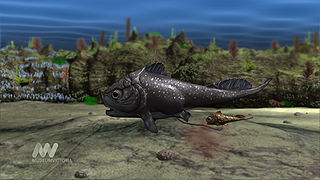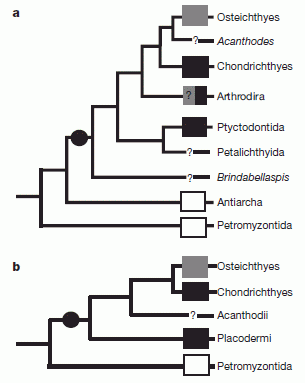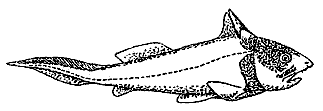Ptyctodontida
Taxa on This Page
- Ptyctodontida
Ptyctodontida - Not So Armor-plated Fish
The Ptyctodontids ("Beak-teeth") were a group of (largely) unarmoured placoderms. With their big heads, big eyes, and long bodies, the Ptyctodontids bore a strong resemblance to modern day chimaeras. Their armor was reduced to a pattern of small plates around the head and neck. Like the well-armored Acanthothoracids, and the holocephalids, the Ptyctodontids lived near the sea bottom and preyed on shellfish.
These unencumbered beasts were once thought to be among the most, if not the most, primitive placoderms, back in the old, old days when placoderms were thought of as being a spectrum of "shark-like and not so armored" to "shell lunchbox with a tail." With the reexamination of Acanthothoraci, the Ptyctodontids have been placed closer to the Arthrodires due to similarities of skull and mouth anatomies.
Some paleontologists have suggested that the Ptyctodontids were not actually placoderms, but actual holocephalids, or even were the ancestors of the holocephalids, including the chimaeras. Thorough anatomical examinations of whole fossil specimens reveal that the profound similiarities between these two groups are actually very superficial. The major differences between them were that holocephalid had shagreen on their skin and ptyctodontids did not, that the armored plates and scales of holocephalids were made of dentine, and the armored plates and scales of ptyctodontids were made of bone, the anatomy of the craniums of holocephalids were more similiar to sharks, and that of ptyctodontids were more similiar to those of other placoderms, and, most importantly, the holocephalids had true teeth, while the ptyctodonts had beak-like tooth-plates. Furthermore, of those ptyctodontids known to have scaly bodies (i.e., Cambellodus decepiens), the anatomy and histology of the scales are very different from the denticles of holocephalids.
The Ptyctodontids were the only known group of placoderms that were verifiably sexually dimorphic, in that the males had pelvic fins modified into clasping organs similiar, if not identical to the clasping organs found in sharks, and chimaeras. The Ptyctodontids' claspers are another important piece of evidence for a relationship between the placoderms and the sharks and chimaeras. Paleontologists believe that the males of the ancestral placoderm had pelvic claspers, but the claspers were lost in the evolutionary development of each of the placoderm orders, save for the Ptyctodontids (there are too few whole specimens of the primitive Stensioella heintzi to tell if the males of that species had claspers or not).
Despite the fact that they lacked the armor of their relatives, the Ptyctodonts were a very successful group, and were able to withstand competition from other, more heavily armored placoderm orders. In fact, when the Acanthothoraci (presumed to be their biggest competitors) went extinct prior to the Mid Devonian extinction event, the Ptyctodonts underwent a radiation that lasted from the Mid Devonian until the extinction of all placoderms at the close of the Devonian. (Long 1995) Stanton 060924
Materpiscis - the mother fish
 |
Ptyctodonts are among the few types of extinct clades of whicxh we have actual fossil evidence of how they reprodoced (ichthyosaurs are another). Here is a model of Materpiscis giving birth. Like sharks, and mammals, these animals had a placenta and umbilical chord. It is not known why this reproductive strategy was discarded in intermediate forms (bony fish, amphibians, reptiles). Museum Victoria, Photo Sularko. Wikipedia MAK111024 |
The following slighly edited material from Wikipedia is provisionally included until we can get around toa better write-up - MAK111024)

Early vertebrate phylogenies showing reproductive strategies. Viviparity has arisen many times in vertebrate evolution using different morphologies for internal fertilization. a, Phylogeny after Brazeau 2009; . b, After Young and Goujet and Young (based on two broad assumptions: (1), placoderm monophyly; (2), all placoderms reproduced by internal fertilization). Black circle, presence of pelvic fins; black rectangle, viviparity with claspers present; grey rectangle, spawning and/or internal fertilization without claspers; white rectangle, spawning mode of reproduction; ?, pelvic region too poorly known to infer reproductive mode. Long et al 2009, diagram © 2009 Macmillan Publishers Limited |
An extraordinarily well-preserved ptyctodontid fossil from the Late Devonian (about 380 million years ago) was discovered at the Gogo Formation of Western Australia. Known from only one specimen, it is unique in having an unborn embryo present inside, and with remarkable preservation of a mineralised placental feeding structure (umbilical cord). Not surprisingly, this new species has been named Materpiscis - the mother fish. The species name honours David Attenborough who first drew attention to the significance of the Gogo fish sites in his 1979 series Life on Earth.
The fossil specimen was found in the Kimberley area of northern Western Australia by Lindsay Hatcher during the 2005 expedition to the Gogo led by John Long of Museum Victoria. Fossils from the Gogo Formation are preserved in limestone nodules, so dilute acetic acid is used to dissolve the surrounding limestone and reveal the fossil.
Examination of the tail section of the Materpiscis specimen led to the discovery of the partially ossified skeleton of a juvenile Materpiscis and the mineralised umbilical cord. The team published their findings in 2008. The ptyctodontid fishes are the only group of placoderms to display sexual dimorphism, where males have clasping organs and females have smooth pelvic fin bases. It had long been suspected that they reproduced using internal fertilisation, but finding fossilised embryos inside both Materpiscis and in a similar form also from Gogo, Austroptyctodus, proved the deduction was true. - Wikipedia
Descriptions
Ptyctodontida:
Phylogeny: Placodermi::: Petalichthyida + *.
usually marine placoderm; <20cm. Look similar to Chimeroids. Armor back of head only. Mostly scaleless. Caudal fin much reduced. Very hard hypermineral "secondary dentine" on tooth plates. Claspers.
Note: I once described ptyctodonts as looking like an upper class Englishman dressed for dinner. I stand by that description. ATW020329.
checked ATW0151003; new page MAK111024


